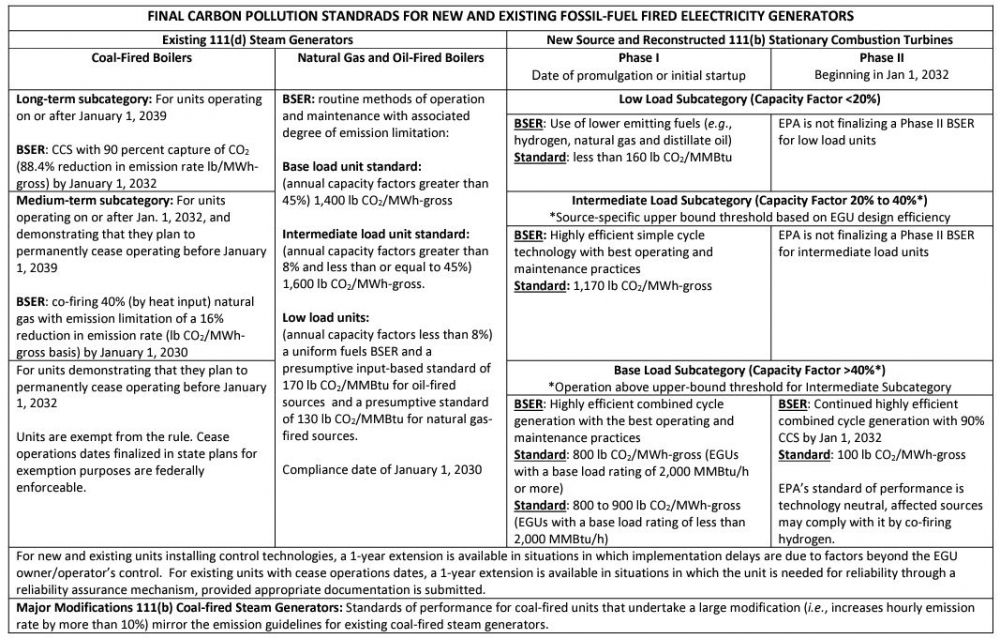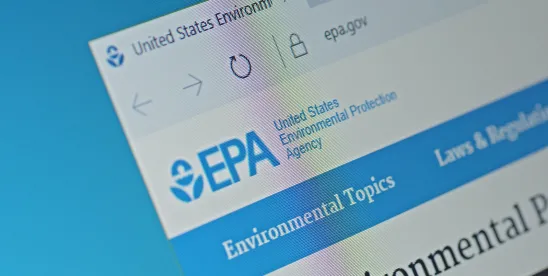Almost one year after proposing sweeping greenhouse gas (GHG) emissions standards for fossil-fired electric generators, the U.S. Environmental Protection Agency (EPA) finalized these regulations on April 26, 2024. Following the proposed rule, the Final Rule identifies carbon capture and storage (CCS) as the “best system of emissions reduction” (BSER) under Section 111 of the Clean Air Act, 42 USC § 7411, and moves forward on that basis. The Final Rule backs off the proposed rule in certain respects. Most importantly, it does not include new regulations of GHG emissions from existing gas-fired turbines that were included in the proposed rules. It also includes some additional flexibility aimed at ensuring electric system reliability. The rule also modifies the compliance deadlines for both fossil-fired steam turbines and new gas-fired turbines.
Key Takeaways
The Final Rule contains the following elements:
- New Source Performance Standards: New and reconstructed gas-fired turbine generators would be required to meet the following standards:
- For low-load “peaking” units, with a capacity factor of less than 20%, EPA will impose a BSER based on the use of fuels with low carbon intensity in high-efficiency generators, resulting in a limit of 160 pounds of CO2 per million British thermal units (lb CO2/MMBtu).
- For “intermediate-load” units, with a capacity factor between 20% and 40%, the BSER will be based on a highly efficient simple-cycle turbine with best operating and maintenance practices, resulting in a GHG limit of 170 lb CO2/MMBtu.
- For baseload units (those with a capacity factor above 40%), EPA adopts a two-phased BSER. The Phase I BSER will be based on highly-efficient combined-cycle generation with best operating and maintenance practices, resulting in a GHG limit of 800 to 900 lb CO2/Btu, depending on the efficiency rating of the generator. The Phase II BSER will require installing CCS capturing 90% of GHG emissions by January 1, 2032, resulting in a GHG emissions limit of 100 lb CO2/MMBtu. The standard can be met by other means, such as firing the generator with hydrogen rather than natural gas.
- EPA did not move forward with Phase II BSER for either peaking or intermediate units.
- EPA clarified that baseload units are those with a capacity factor above 40%, replacing the proposed rule’s approach, which could have resulted in a threshold of between 33% and 50% depending on the characteristics of a particular generator.
- The deadline for compliance with the Phase II BSER for baseload units was moved up to 2032, whereas EPA originally proposed a 2035 compliance deadline.
- GHG Limits on Existing Fossil-Fired Steam Generation: The rule imposes different standards for existing coal-fired steam turbines and steam turbines fired by natural gas or oil. For existing coal-fired steam generators, EPA adopted the proposal to impose different standards based on the anticipated date a particular unit will be retired.
- For “imminent-term” units – those committed to retire no later than January 1, 2032, with that commitment reflected in a state implementation plan – no new requirements will be imposed. This retreats from the proposed rule, which would have required imminent-term units to adopt best operating practices.
- For “medium-term” units – those that will operate beyond 2032 but will commit to retiring before January 1, 2039 – the final rule requires co-firing with 40% natural gas to attain a 16% reduction in GHG emissions by January 1, 2030.
- For “long-term” units – those operating past 2040 – installation of CCS would be required to capture 90% of the plant's CO2 emissions by January 1, 2032.
- For existing steam turbines fired by natural gas or oil, the final rule imposes standards similar to the NSPS for new natural gas turbines based on whether the units are classified as baseload, peaking, or intermediate units.
- Repeal of the ACE Rule: The final rule follows the proposed rule by repealing the ACE Rule, including several critical findings contained in the ACE Rule. For example, EPA now concludes that advances in CCS technology make it “adequately demonstrated,” so the opposite conclusion in the ACE Rule is no longer valid.
- Deferral of Rules for Existing Gas-Fired Turbines: In the proposed rule, EPA included a plan to apply GHG restrictions to the nation’s fleet of existing gas-fired turbines. The final rule drops this proposal. Instead, EPA has opened a non-regulatory docket seeking comments on how the agency can best regulate GHG emissions from the nation’s existing fleet of gas-fired turbine generators, including a public forum to address this issue scheduled for May 17, 2024.
- Reliability Guardrails: The final rule includes two provisions intended to ameliorate the risks to electric reliability of prematurely retiring fossil-fired generators. First, the Final Rule exempts fossil-fired generators from the GHG standards during grid emergencies. Second, facilities subject to the requirements to install CCS technology may be allowed an extra year to meet this requirement if grid operators cannot secure generation to replace that power so that electric system reliability is maintained.
- State Implementation Plans: States will be required to file implementation plans that meet the Final Rule’s requirements for reducing GHG emissions from existing fossil-fired plants within two years.
- Regulatory Quartet: The Final Rule is one of four rules governing coal-fired generation adopted simultaneously by EPA. The other three are: (1) a final rule updating EPA’s Mercury and Air Toxics Rule that would require a 70% reduction in mercury emissions over 2012 levels from existing lignite coal-fired sources and a 67% reduction in filterable particulate matter; (2) a final rule requiring significant reductions in discharges of toxic metals and other pollutants in wastewater from coal-fired plants; and, (3) a final rule governing cleanup of coal ash disposal areas.
The following table from EPA summarizes the BSER as adopted in the final rule:
Background and Analysis
As noted in our discussion of EPA’s proposed rule, the Final Rule is the latest gambit in a years-long legal chess match. The legal underpinnings of the Final Rule date back at least as far as the U.S. Supreme Court’s decision in Massachusetts v. EPA, 549 U.S. 497 (2007), which held that GHGs are “pollutants” under the Clean Air Act and that EPA is required to make a finding whether GHGs endanger the public health and, if so, to regulate GHGs. EPA in 2009 concluded that GHGs endanger the public health. Since then, EPA has struggled to find an effective approach to GHG regulation that accords with the policy goals of particular presidential administrations, fits within the Clean Air Act’s statutory authorities, and survives the inevitable litigation.
Most recently, in West Virginia v. EPA, the Supreme Court struck down the EPA’s conclusion in the Obama Administration’s Clean Power Plan that an “outside the fence” approach, including a cap-and-trade system, that would result in a shift of electricity production from coal-fired plants to other sources with lower GHG emissions exceeded EPA’s power under Section 111(d) to establish the “best system of emissions reductions” that has been “adequately demonstrated.” In that decision, the Court, for the first time, adopted the “major questions doctrine” as an explicit test of the federal agency’s statutory authority and concluded that EPA exceeded its authority under Section 111(d) in attempting to impose a cap-and-trade system to regulate GHG emissions rather than technological pollution controls that EPA has traditionally relied on the address air pollution.
There is little doubt that the Final Rule is not the final word on EPA’s power to regulate GHG emissions. Litigation challenging the Final Rule has already been threatened, and litigants will likely revisit the major questions doctrine and challenge EPA’s conclusion that CCS technology has been “adequately demonstrated.” In addition, should the Trump Administration be returned to power in this fall’s election, there is little doubt that a Trump EPA would attempt to repeal the Final Rule, as it did with the Obama Administration’s Clean Power Plan.
Conclusion
The Final Rule is EPA’s latest and most ambitious regulatory initiative to reduce GHG emissions from the nation’s electric power industry. Because litigation over the rule is all but certain and a change in administrations could also produce a significant change in priorities related to GHG reductions, the Final Rule is unlikely to settle the question of how GHGs from the nation’s electric system should be regulated.





 />i
/>i

